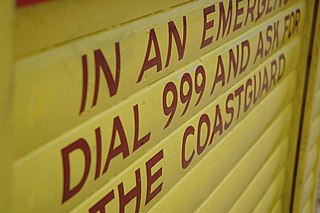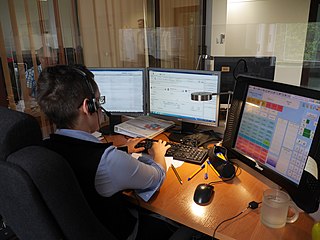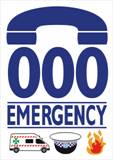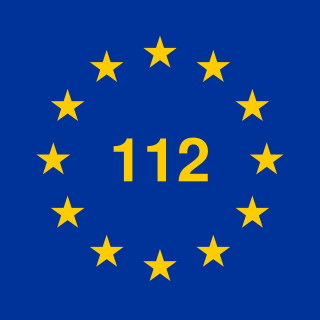Related Research Articles

Pulse dialing is a signaling technology in telecommunications in which a direct current local loop circuit is interrupted according to a defined coding system for each signal transmitted, usually a digit. This lends the method the often used name loop disconnect dialing. In the most common variant of pulse dialing, decadic dialing, each of the ten Arabic numerals are encoded in a sequence of up to ten pulses. The most common version decodes the digits 1 through 9, as one to nine pulses, respectively, and the digit 0 as ten pulses. Historically, the most common device to produce such pulse trains is the rotary dial of the telephone, lending the technology another name, rotary dialing.
In telephony, ringdown is a method of signaling an operator in which telephone ringing current is sent over the line to operate a lamp or cause the operation of a self-locking relay known as a drop.

911, sometimes written 9-1-1, is an emergency telephone number for Argentina, Canada, Dominican Republic, Jordan, Mexico, Pakistan, Palau, Panama, the Philippines, Sint Maarten, the United States, and Uruguay, as well as the North American Numbering Plan (NANP), one of eight N11 codes. Like other emergency numbers around the world, this number is only intended for use in emergency circumstances. Using it for any other purpose is a crime in most jurisdictions. Penalties for abuse/misuse of 911 can range from probation/community service to fines/jail time. Offenders can also be ordered to undergo counseling and have their use of telephones restricted or suspended for a period time as a condition of probation.

An emergency telephone number is a number that allows a caller to contact local emergency services for assistance. The emergency number differs from country to country; it is typically a three-digit number so that it can be easily remembered and dialed quickly. Some countries have a different emergency number for each of the different emergency services; these often differ only by the last digit.

999 is an official emergency telephone number in a number of countries which allows the caller to contact emergency services for emergency assistance. Countries and territories using the number include Bahrain, Bangladesh, Botswana, Eswatini, Ghana, Guernsey, Hong Kong, the Republic of Ireland, the Isle of Man, Jersey, Kenya, Macau, Malaysia, Mauritius, Poland, Qatar, Sudan, Saudi Arabia, Singapore, Trinidad and Tobago, Seychelles, Uganda, the United Arab Emirates, the United Kingdom, and Zimbabwe.

3-1-1 is a special telephone number supported in many communities in Canada and the United States. The number provides access to non-emergency municipal services. The number format follows the N11 code for a group of short, special-purpose local numbers as designated in the North American Numbering Plan.
Operator assistance refers to a telephone call in which the calling party requires an operator to provide some form of assistance in completing the call. This may include telephone calls made from pay phones, calls placed station-to-station, person-to-person, collect, third number calls, calls billed to a credit card, and certain international calls which cannot be dialed directly. The telephone operator may also be able to assist with determining what kind of technical difficulties are occurring on a phone line, to verify whether a line is busy, or left off the hook, and break in on a phone line to request for the caller to clear the line for an incoming call. The latter service is often utilized by emergency police. In addition, operators are often a first point of contact for the elderly wanting information on the current date and time.
111 is the emergency telephone number in New Zealand. It was first implemented in Masterton and Carterton on 29 September 1958, and was progressively rolled out nationwide with the last exchanges converting in 1988.

In the United Kingdom, telephone numbers are administered by the Office of Communications (Ofcom). For this purpose, Ofcom established a telephone numbering plan, known as the National Telephone Numbering Plan, which is the system for assigning telephone numbers to subscriber stations.

A public-safety answering point (PSAP), sometimes called a public-safety access point, is a type of call center where the public's telephone calls for first responders are received and handled. It takes calls from any landline, mobile phone line, or VoIP line. It can also happen that when 112 is dialed in then a logic is implemented by mobile or network operators to route the call to the nearest police station. Such call centers exist in most countries to answer calls to an emergency telephone number. Trained telephone operators are also usually responsible for dispatching these emergency services. Most PSAPs are now capable of caller location for landline calls, and many can handle mobile phone locations as well, where the mobile phone company has a handset to location system. Some can also use voice broadcasting where outgoing voice mail can be sent to many phone numbers at once, in order to alert people to a local emergency such as a chemical spill.

000 Emergency, also known as Triple Zero or Triple 0, and sometimes stylised Triple Zero (000), is the primary national emergency telephone number in Australia and Australian External Territories. The Emergency Call Service is operated by Telstra, and overseen by the Australian Communications and Media Authority (ACMA), and is intended only for use in life-threatening or time-critical emergencies.

112 is a common emergency telephone number that can be dialed free of charge from most mobile telephones, and in some countries, fixed telephones in order to reach emergency services.
119 (one-one-nine) is an emergency telephone number in parts of Asia and in Jamaica. From May 2020, 119 was introduced in the United Kingdom as the single non-emergency number for the COVID-19 testing helpline in England, Wales, and Northern Ireland. From January 2022, 119 was introduced in Romania as the single non-emergency number for reporting cases of abuse, neglect, exploitation and any other form of violence against the child.
The Brazilian telephone numbering plan uses a two-digit area code plus eight-digit local phone numbers for landlines and nine digits for mobile lines. Public utility services use short phone numbers, always starting with 1.

The New Zealand telephone numbering plan describes the allocation of telephone numbers in New Zealand and the Pitcairn Islands.
Telephone numbers in the United Arab Emirates (UAE) follow a closed telephone numbering plan. The UAE is assigned an international dialing code of +971 by ITU-T. Telephone numbers are fixed at seven digits, with area codes fixed at two or three digits.
National conventions for writing telephone numbers vary by country. The International Telecommunication Union (ITU) publishes a recommendation entitled Notation for national and international telephone numbers, e-mail addresses and Web addresses. Recommendation E.123 specifies the format of telephone numbers assigned to telephones and similar communication endpoints in national telephone numbering plans.
101 is the police single non-emergency number (SNEN) in the United Kingdom (UK), which automatically connects the caller to their local police force, in a similar manner to the pre-existing 999 emergency number. The 101 service was created to ease pressure, and abuse of the existing 999 system. Hazel Blears, then a UK government minister in the Home Office, stated that the new system would "strengthen community engagement". In 2004, ten million 999 calls were made in the UK; however, 70% of those calls were deemed not to be an emergency.
The 999 phone charging myth is an urban legend that claims that if a mobile phone has low battery, then dialling 999 charges the phone so it has more power. This was confirmed as untrue by several British police forces who publicly cited the dangers of making such calls.
References
- 1 2 Osborne, Hilary (12 June 2015). "Power cut? Dial 105 wherever you are in the UK". The Guardian . Retrieved 12 January 2018.
- 1 2 "Police announces non-emergency number – it's 105". New Zealand Police. 10 May 2019. Retrieved 20 June 2019.
- ↑ "Dial '105' for electricity helpline". Ofcom . 12 June 2015. Archived from the original on 13 January 2018. Retrieved 12 January 2018.
- ↑ Finnigan, Lexi (6 September 2016). "New national phone line launched for power cuts". The Telegraph . Retrieved 12 January 2018.
- ↑ Sayid, Ruki (12 June 2015). "There's a new phone number to ring if you're hit by a power cut". Daily Mirror . Retrieved 12 January 2018.
- ↑ "Backyard banter Police launch 105 nonemergency call number". Stuff (Fairfax). 28 May 2019.
- ↑ "In a nonemergency call 105 Police launch new number for crimes that pose no immediate danger". Stuff (Fairfax). 10 May 2019.